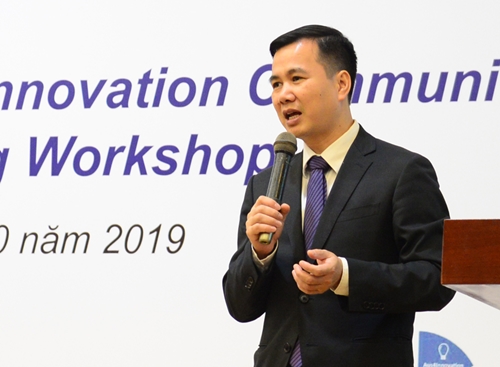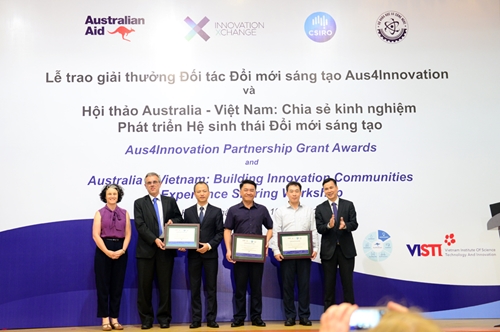To begin the workshop, a representative of the Vietnam Institute of Science, Technology and Innovation gave a briefing on the network of innovation organizations in Vietnam and Vietnam’s startup ecosystem. According to him, Vietnam has formed an innovation ecosystem for decades, but it has yet to operate effectively as it has not had close connection or collaboration between/among its components: governmental agencies, research and education institutions, enterprises and communities.
In this circumstance, he affirmed that Vietnam’s innovation ecosystem has both gaps and opportunities. He suggested Vietnam should have a network of innovation centers; each innovation center should set its own specific objectives and develop its own specific innovation services and products. They should also create connections with relevant governmental agencies, sponsors, other innovation centers, as well as with clients, enterprises and community as a whole.
    |
 |
|
Deputy Minister of Science and Technology Bui The Duy addresses at the workshop |
Petr Damek, CEO of the Canberra Innovation Network (CBRIN), introduced his innovation network, as well as its main components: Center for Entrepreneurial Agritech, Renewable Innovation Hub, SpaceTech Hub, Sports & well-being precinct, Defense industry network and OZ Cyber Innovation Node. To achieve success, the CEO said, CBRIN should have working plans for its short-term development, strategic directions for middle term development and visions for long term. Generally, CBRIN continuously expands its network of entrepreneurs and innovators with high quality programs. It also has a system monitoring the entire network’s operation and regularly reviews outcomes of its operation.
He also shared experience in creating an innovation community. As finance for projects is always a hard issue, he recommended ways to seek funds. Finally, he shared effective approaches to matching funding for research and technology development and key capability areas to universities.
Collaboration – building innovation communities as a way forward
Delegates at the workshop first focused their discussion on trends for the development of an innovation ecosystem. Some delegates said that the collaboration between education and training institutions, research institutes and industry is very important. Without this connection, there will be no innovation ecosystem.
Furthermore, they mentioned the need to urbanize clusters anchored around key networked institutions and regionalize innovation groupings. A member of CBRIN underscored that capacity and strength of networked institutions will increase a lot if they can include local innovation clusters with similar objectives.
    |
 |
|
Rebecca Bryant, Charge d’Affaires a.i. of the Australian Embassy (left) and Deputy Minister of Science and Technology Bui The Duy (right) in a joint photo with authors of outstanding innovation projects |
Other delegates from CBRIN talked about the new organization of an innovation ecosystem has now shifted from Triple-Helix (academia-business-government) to Quadruple Helix (plus the participation of citizens). They also pointed out the need to include small- and medium-sized enterprises (SMEs) as well as to develop virtual breeding environments and virtual organizations that are connected together via information and communication technology (ICT).
Most delegates agreed that, in order to be successful, the innovation ecosystem should develop its own structure and strategy, resources and skills, and culture.
Another focused issue that was drawn much attention from delegates at the workshop was success factors or/and lessons learn from the reality. Delegates stressed that the path to develop an innovation ecosystem is not very smooth so there may be problems, adversities, coordination failures and missed opportunities. These are considered inevitable things that must be surpassed in developing an innovation ecosystem.
To minimize risks, the innovation ecosystem should form a coalition of the willing, involving leaders and innovation ambassadors. Delegates underscored that collaboration is key, it is not easy and it needs to be the focus and without effort it disappears (collaboration must be a program of its own).
Meanwhile, other delegates saw programs, including established and emerging community-based or ecosystem based initiatives, and long views as important factors. They said that each innovation center/network should have its own workplans and strategy while the whole innovation ecosystem should have long views to lead all innovation centers/networks to develop in the long run. Many delegates saw these as the key to success.
    |
 |
|
Rebecca Bryant, Charge d’Affaires a.i. of the Australian Embassy speaks at the event. |
Several members of CBRIN also shared their experiences, saying that any programs should be in line with the national development strategy, approach enterprise/enterprises’ business or/and production plans, or benefit a community. If so, the whole program or part of the program can easily get an access to funding sources.
Australia’s commitment to supporting innovation projects in Vietnam
As part of the workshop, the Australian Government officially presented grants to three outstanding innovation projects. The first project that is conducted by the Genecology Research Center of University of the Sunshine Coast (USC) and Research Institute for Aquaculture No.3 (RIA3) proposes innovative solutions to the production of sea cucumbers in Vietnam. The second, conducted by University of Technology Sydney (UTS) and Vietnamese National University of Engineering and Technology (VNU-UET), uses advanced engineering and IT approaches of University of Technology of Sydney (UTS) to treat water for aquaculture in Phu Yen province and the Red River Delta. Meanwhile, the third, run by the University of Sydney and the National Health Strategy and Policy Institute (NHSPI), aims at transforming breast cancer diagnoses across Vietnam. Based on advanced Australian and New Zealander breast cancer diagnosis technologies, a group of Vietnamese doctors has developed a smart breastscreen reader system helping doctors diagnose breast cancer more accurately and effectively in Vietnam.
Addressing the event, Deputy Minister of Science and Technology Bui The Duy thanked the Australian Government for its effective support for innovation projects in Vietnam, and called on the Australian Government and Australian Embassy in Vietnam to provide further support for Vietnamese startups and innovation projects. He said, “The innovation partnership between Australia and Vietnam has proven to be an effective mechanism for the two countries to share best practice and models to enhance the innovation systems in both countries. We hope, grants provided under the Aus4Innovation program will set examples of how innovation – particularly when it can be jointly developed and implemented – can transform our society and faciliate economic, social and environmental sustainability.” He also urged Australian organizations, businesses and experts to share their experiences and success stories about innovation as well as learned lessons on the development of an innovation ecosystem.
Meanwhile, Ms. Rebecca Bryant, Charge d’Affaires a.i. of the Australian Embassy, affirmed, “Deeper, stronger ties between our innovation systems are a key goal for our strategic partnership with Vietnam and the Innovation Partnership Grants provide excellent opportunities to nurture innovative ideas and scale on-going partnerships between Australian and Vietnamese organizations. I’m delighted to see more and more collaboration between the research institutions of our two countries.” She reiterated, the Australian Government will continue to support Vietnam’s innovation ecosystem by funding outstanding innovation projects in Vietnam as well as by sharing experience in developing innovation centers, networks and the innovation ecosystem as a whole.
“Australia will grant AUD 2.4 million by the end of this year to outstanding innovation projects in Vietnam,” Ms. Bryan released.
|
In November 2017, Australia and Vietnam announced the creation of the Australia-Vietnam Innovation Partnership. The partnership recognizes that innovation systems are critical to driving sustainable and inclusive economic growth that lifts. The Aus4Innovation program is an AUD 10 million development assistance program being enacted under the Australia Vietnam innovation partnership. Its central objective is to strengthen Vietnam’s innovation system, prepare for and embrace opportunities associated with Industry 4.0, and help shape Vietnam’s innovation agenda in science and technology. Through the Aus4Innovation program, Australia and Vietnam will together explore emerging areas of technology and digital transformation, trial new models for partnerships between public and private sector institutions, and strengthen Vietnamese capability in digital fore-sighting, scenario planning, commercialization and innovation policy.
The Innovation Partnership Grant is an important part of the AUD 10 million, four year (2018-2022) flagship Aus4Innovation program to help strengthen the Vietnamese innovation system and prepare for Vietnam’s economic and digital future. It is co-funded by the Australian Department of Foreign Affairs and Trade (DFAT) and Innovation Xchange (IXC), managed by the Australian Commonwealth Scientific and Industrial Research Organization (CSIRO), and in strategic collaboration with the Ministry of Science and Technology of Vietnam (MoST).
|
Reported by Thu Nguyen - Thu Ha